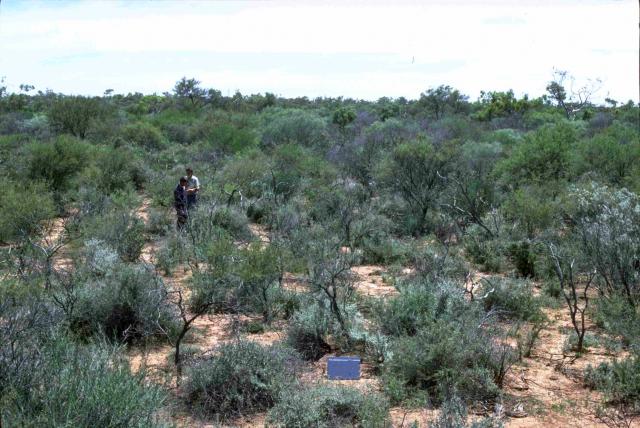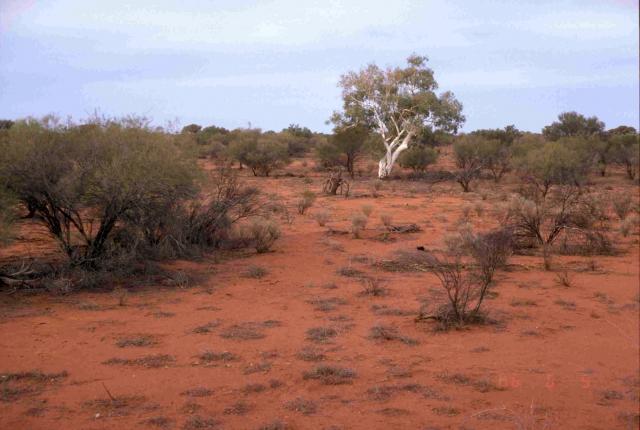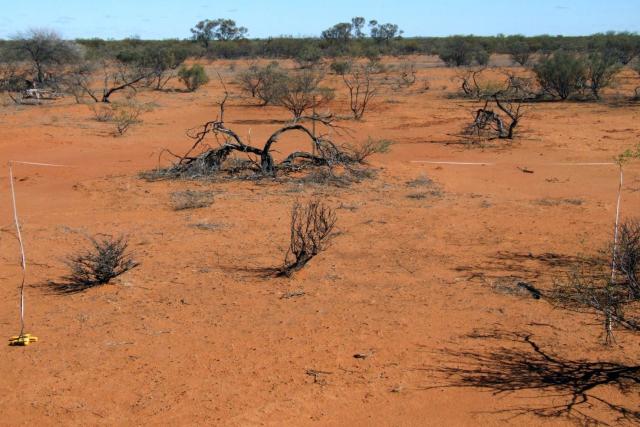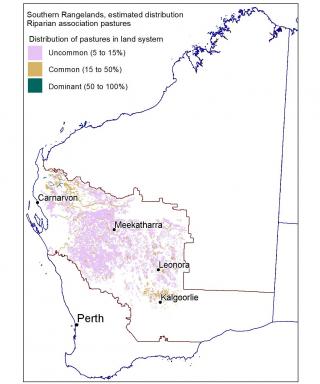Pastoral potential – high
Riparian association pastures are very valuable for pastoral use and have considerable drought durability when in good condition. These pastures are suitable for year-round use by all classes of livestock, provided stocking rates are conservative. Good condition riparian association pastures tolerate occasional floods and storms without significant soil loss.
Suggested levels of use (per annum)
Table 1 provides a rough guide to the range of pastoral values for good condition pastures, which must be checked against conditions in each region and paddock. Carrying capacities for fair condition pastures might be 75% to 50% of good, and poor condition pastures less than 50% of good.
See Introduction to pastures in the southern rangelands of Western Australia for an explanation of how carrying capacities are estimated.
| Condition | Carrying capacity ha/DSE1 | Carrying capacity ha/CU2 (ha/AE3) |
|---|---|---|
| Good | 5.1–9.9 | 36–69 (43–83) |
1 DSE is based on the feed energy required to maintain a 45 kilogram liveweight Merino wether with zero weight change, no wool growth additional to that included in maintenance, and walking 7 km/day. 1 DSE has an energy requirement of approximately 8.7 MJ ME/day.
2 CU in the southern rangelands is based on a 400 kg steer at maintenance and equivalent to 7 DSE.
3 AE is based on the feed energy to maintain a 450 kg Bos taurus steer 2.25 years of age, walking 7 kilometers each day. 1 AE has an energy requirement of approximately 73 MJ ME/day and equivalent to 8.4 DSE.
Management
Riparian association pastures are preferentially grazed by livestock, and are susceptible to overgrazing. Fencing these pastures allows for control of grazing pressure.
Maintaining adequate plant cover is essential to prevent soil loss. Excessive grazing, especially in dry years, kills the desirable perennial shrubs and reduces soil cover, leading to soil loss through floods and strong winds, exposing the subsoils. The topsoil and its associated plants cannot be replaced. This transition can occur over just a few years or in the course of one major flood event.
Summer rainfall events may allow buffel and birdwood grasses to colonise these pastures. After the initial summer growth flush, protein levels fall and animals will graze remnant shrubs heavily in an effort to maintain protein intake and contribute to the invasive process. Buffel grass colonisation increases the risk of fire and may irreversibly change the pasture type.
Pastures in fair or poor condition will require periodic spelling if condition is to be improved. Spelling during and immediately after the growing season until seedlings are well established and mature plants have set seed (six months or more) is recommended.
Buffel grass colonisation increases the risk of fire and may irreversibly change the pasture type. Strong stands of exotic perennial buffel and/or birdwood grasses (Cenchrus ciliaris and C. setiger) are established throughout many northern riparian association pastures. The reduced plant diversity associated with Cenchrus colonisation identifies this pattern of pasture change as a decline in condition from an ecological standpoint. However, transformed pastures have proven to deliver livestock productivity on par with or higher than native pastures they have replaced when in good condition and in good seasons with good grazing management. Perennial Cenchrus pastures (including transformed riparian association pastures) are in good condition where the living basal cover exceeds 4%.
Pasture condition
Good condition
See Figure 1. These pastures are dominated by saltbushes in good condition. These pastures may also support a diverse range of palatable plants such as tall sida, tall saltbush and ruby saltbush, with annual herbs and grasses growing between the shrubs in good seasons.
Young bluebush and saltbush plants are present in the stand. Occasional bardie bush, needlebush and silver poverty bush may be present. Cryptogamic soil crusts are evident and there is little soil erosion.
Strong stands of exotic perennial buffel and/or birdwood grasses (Cenchrus ciliaris and Cenchrus setiger) are established throughout many northern riparian association pastures in the shrublands. The reduced plant diversity associated with Cenchrus colonisation identifies this pattern of pasture change as a decline in condition from an ecological standpoint; however, transformed pastures under expert grazing management have proven to deliver livestock productivity on par with intact native good condition pasture that they have replaced.
Perennial Cenchrus pastures (including transformed riparian association pastures) are in good range condition where the living basal cover attains of exceeds 4%.
Fair condition
See Figure 2. This is indicated by a reduced population of desirable shrubs and perennial grasses. Bardie bush may increase as more favoured shrubs disappear. The reduced cover of desirable plants may allow undesirable shrubs to proliferate if conditions for germination are favourable. Cryptogamic soil crusts are present, but some breakdown of crusts may be evident. Occasional minor to moderate wind and water erosion may be present.
Poor condition
See Figure 3. Total vegetation cover is reduced with very few or no desirable shrubs remaining. Overall perennial plant diversity is diminished. In some cases, the only palatable plants remaining will be annuals in good seasons. Degraded pastures may be invaded by unpalatable larger shrubs such as needlebush, bardie bush, wait-a-while, crinkle leaf cassia and silver poverty bush. Cryptogamic crusts are poorly developed, patchy or absent. Active moderate to severe erosion is likely.



Vegetation structure and composition
Saltbush is a prominent pasture feature when these pastures are in good condition. Prominent low shrubs vary with geographical location and local factors. Medium shrubs including green cassia and tall saltbush are common. Desirable low shrubs other than saltbushes are diverse and may include sago bush, cotton bushes and goosefoots. Trees and tall shrubs are diverse and may be close to scattered. Undesirable shrubs include bardie bush, needlebush and silver poverty bush.
Introduced buffel and birdwood grasses have colonised many riparian association pastures: in the case that transition to a stable buffel or birdwood grass pasture has occurred, the management advice for buffel grass pastures applies (see Buffel grass pastures).
Occurrence
Riparian association pastures occur on flood plains and river frontages of major river systems of the Gascoyne and Murchison regions and ephemeral creeks of the Goldfields, and cover an estimated 1.81 million hectares (2.2% of the southern rangelands). Soils are relatively fertile and underlain by clay. Sand or loam may be present on the surface. Cryptogamic crusts cover a major proportion of the soil surface. Soil depth varies depending on condition with some soils more than a metre deep, while others are shallow and eroded.
Associated plants
| Common name | Scientific name | Desirability* |
|---|---|---|
| Berrigan | D | |
| Buffel/birdwood grasses | Cenchrus spp. and hybrids | D |
| Cotton bush | D | |
| Currant bush | D | |
| Feather speargrass | D | |
| Fuchsia bush | D | |
| Green cassia | D | |
| Green fuchsia bush | D | |
| Neverfail | D | |
| Ribbon grass | D | |
| Roebourne plains grass | D | |
| Ruby saltbush | D | |
| Scrambling saltbush | D | |
| Silver saltbush | D | |
| Swamp saltbush | D | |
| Tall saltbush | D | |
| Tall sida | D | |
| Warty-leaf eremophila | D | |
| Bardie bush | U | |
| Crinkle leaf cassia | U | |
| Grey cassia, desert cassia | U | |
| Needlebush | U | |
| Sandbank poverty bush | U | |
| Silver cassia, banana-leaf cassia | U | |
| Silver poverty bush | U | |
| Spear-fruit copperburr | U | |
| Straight leaf cassia, variable cassia | U | |
| Turpentine bush | U | |
| Wait-a-while | U | |
| Beefwood | I | |
| Bloodbush | I | |
| Claypan grass | I | |
| Curara, Kurara | I | |
| Fine leaf jam | I | |
| Limestone wattle | I | |
| Mulga | I | |
| Native willows | Pittosporum spp. | I |
| Sago bush | I | |
| Cottony saltbush | I | |
| Waterbush | I | |
| Wilcox bush | I | |
| Coolibah | N | |
| River red gum | N |
* D = desirable, U = undesirable, I = intermediate, N = no indicator value


